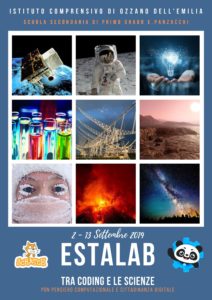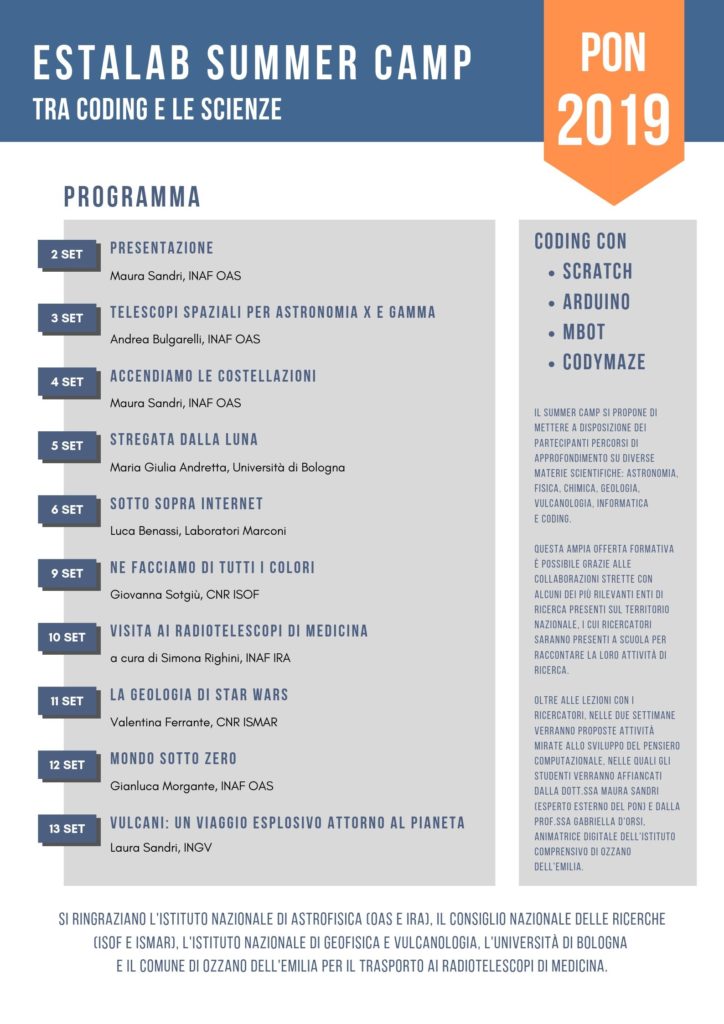Estalab, between coding and sciences
The summer camp – which took place at the Istituto Comprensivo di Ozzano dell’Emilia (Bologna) from September 2 to 13, 2019, from 9 to 12, for a total of 30 hours – made available to participants courses of study on different scientific disciplines: Astronomy, Physics, Chemistry, Geology, Vulcanology, and Computer Science.
This wide educational offer was possible through the collaboration – coordinated by INAF – with some of the most relevant Research Institutes of the country, some of whose researchers went to school to describe their activities. Over and above lessons with the researchers, in these two weeks a number of activities were proposed in order to develop computational thinking, through coding with Scratch.
This is the programme of the two weeks:
- Monday 2: Presentation of the summer camp (Maura Sandri, INAF OAS) + Coding
- Tuesday 3: Space Telescopes for X and Gamma Astronomy (Andrea Bulgarelli, INAF OAS) + Coding
- Wednesday 4: Let us light up the Constellations (Maura Sandri, INAF OAS) + CodyMaze
- Thursday 5: Moonstruck (Maria Giulia Andretta, Università di Bologna) + Coding
- Friday 6: Under and over Internet (Luca Benassi, Laboratori Marconi) + Coding
- Monday 9: We make all the colours (Giovanna Sotgiù, CNR ISOF) + Coding
- Tuesday 10: Visiting the radiotelescopes of Medicina (Simona Righini, INAF IRA)
- Wednesday 11: The Geology of Star Wars (Valentina Ferrante, CNR ISMAR) + Coding
- Thursday 12: World below zero (Gianluca Morgante, INAF OAS) + Coding
- Friday 13: Volcanoes: an explosive journey around the planet (Laura Sandri, INGV) + Conclusion
Here is the detail of the days:
Day 1
Presentation of the summer course programme and start of the work with Scratch. Participants, already trained in using the programming environment during the school year, have been invited to prepare a presentation with Scratch, describing three things about themselves, by using techniques of digital storytelling, with the constraint of using only one sprite and working on its costumes. At the end of the three hours, all the works were loaded in a drive folder shared by the tutor.
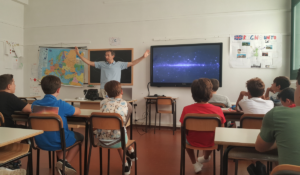 In the first part of the day, Maura Sandri introduced the electromagnetic spectrum (from radio waves to gamma rays, passing through the visible), how the differet frequencies from Earth and Space are detected, and the importance of each band in research and in everyday life. Later on, Andrea Bulgarelli (technologist of INAF OAS) talked about space telescopes for X and Gamma Astronomy, describing his own personal experience in developing the Agile mission of the Italian Space Agency. At the end of the 60 min. lesson, participants continued to work on their presentation with Scratch, with the support of the INAF expert and of the tutor.
In the first part of the day, Maura Sandri introduced the electromagnetic spectrum (from radio waves to gamma rays, passing through the visible), how the differet frequencies from Earth and Space are detected, and the importance of each band in research and in everyday life. Later on, Andrea Bulgarelli (technologist of INAF OAS) talked about space telescopes for X and Gamma Astronomy, describing his own personal experience in developing the Agile mission of the Italian Space Agency. At the end of the 60 min. lesson, participants continued to work on their presentation with Scratch, with the support of the INAF expert and of the tutor.
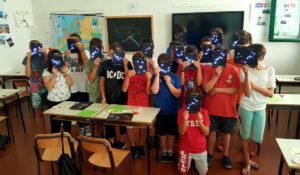 In the first part of the day, we organized the laboratory Let us light up the constellations. This lab allowed us to bring pupils closer to electronics, by using Astronomy as leitmotif in order to realize a product of considerable visual impact: a paper circuit in which the stars of the constellations light up, shining upon a specially designed black cardboard. When realizing this circuit, participants easily and intuitively learned the basics of electricity, and how electric circuits work. The general introduction about the sky, the constellations, the stars and the diffused objects belonging to the Messier catalogue, brought pupils closer to the study of Astronomy, and to the world of scientific research. The constellations proposed in this lab were studied in depth, with the description copied on the cardboard of each participant, in terms of type of stars, position in the sky, and presence of interesting objects inside the constellation itself.
In the first part of the day, we organized the laboratory Let us light up the constellations. This lab allowed us to bring pupils closer to electronics, by using Astronomy as leitmotif in order to realize a product of considerable visual impact: a paper circuit in which the stars of the constellations light up, shining upon a specially designed black cardboard. When realizing this circuit, participants easily and intuitively learned the basics of electricity, and how electric circuits work. The general introduction about the sky, the constellations, the stars and the diffused objects belonging to the Messier catalogue, brought pupils closer to the study of Astronomy, and to the world of scientific research. The constellations proposed in this lab were studied in depth, with the description copied on the cardboard of each participant, in terms of type of stars, position in the sky, and presence of interesting objects inside the constellation itself.
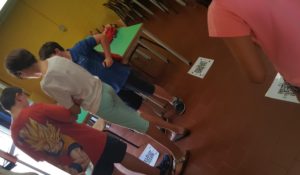 At the end of the 90 min. activity, participants experimented Cody Maze, a virtual labyrinth in the real world, created by Alessandro Bogliolo of the University of Urbino. You move upon a 5 x 5 chessboard, whose squares contain QRcodes. Apparently, the chessboard is free; however, thanks to the Qrcodes, it shows ever different labyrinths, which are proposed to the player by a Telegram bot called @codymazebot. The player physically moves upon the chessboard while following the bot’s instructions, and scans the QRcode on which he/she arrives at each stage, to check whether he/she correctly executed the sequence of instructions. During the various stages of the game, instruction sequences of increasing complexity are proposed, which introduce all the basic concepts of programming, thus offering an experience equivalent to the classical labyrinth of the “hour of code”, but each time different, and played physically. At the end of the game, the Telegram bot releases a certificate to the player’s name, for the completion of a coding hour, with the list of all programming constructs tested during the game.
At the end of the 90 min. activity, participants experimented Cody Maze, a virtual labyrinth in the real world, created by Alessandro Bogliolo of the University of Urbino. You move upon a 5 x 5 chessboard, whose squares contain QRcodes. Apparently, the chessboard is free; however, thanks to the Qrcodes, it shows ever different labyrinths, which are proposed to the player by a Telegram bot called @codymazebot. The player physically moves upon the chessboard while following the bot’s instructions, and scans the QRcode on which he/she arrives at each stage, to check whether he/she correctly executed the sequence of instructions. During the various stages of the game, instruction sequences of increasing complexity are proposed, which introduce all the basic concepts of programming, thus offering an experience equivalent to the classical labyrinth of the “hour of code”, but each time different, and played physically. At the end of the game, the Telegram bot releases a certificate to the player’s name, for the completion of a coding hour, with the list of all programming constructs tested during the game.
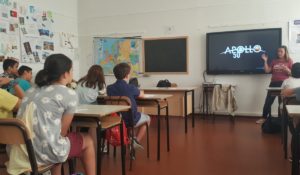 50 years since man first landed on the Moon, together with Maria Giulia Andretta (Phd in History of Science and Techniques, and author of the book Stregati dalla Luna) we celebrated that “small step”, retracing the most significant stages of the extraordinary undertaking which brought humankind upon the Moon surface. The researcher brought exclusive testimony of how NASA celebrated the new lunar year, as well as an anticipation on new space programs. At the end of the 90 min. talk, we suggested that participants should realize a multi-level video game based upon their own labyrinths.
50 years since man first landed on the Moon, together with Maria Giulia Andretta (Phd in History of Science and Techniques, and author of the book Stregati dalla Luna) we celebrated that “small step”, retracing the most significant stages of the extraordinary undertaking which brought humankind upon the Moon surface. The researcher brought exclusive testimony of how NASA celebrated the new lunar year, as well as an anticipation on new space programs. At the end of the 90 min. talk, we suggested that participants should realize a multi-level video game based upon their own labyrinths.
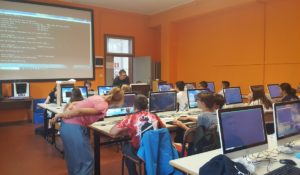 Luca Benassi (from Laboratori Guglielmo Marconi, with a degree in Computer Science) talked about Internet, how it was born, and how it developed on a global level. He introduced data transmission protocols, and how transmission takes place. After the first part of the lesson in the classroom, in the computer lab participants were “initiated” to a few basic commands of the DOS shell, which allowed them to understand the bases of TCP/IP connections, both inside the local network and towards Internet.
Luca Benassi (from Laboratori Guglielmo Marconi, with a degree in Computer Science) talked about Internet, how it was born, and how it developed on a global level. He introduced data transmission protocols, and how transmission takes place. After the first part of the lesson in the classroom, in the computer lab participants were “initiated” to a few basic commands of the DOS shell, which allowed them to understand the bases of TCP/IP connections, both inside the local network and towards Internet.
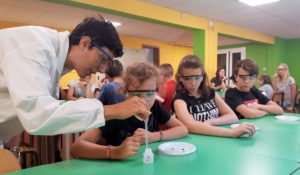 Giovanna Sotgiù, researcher of CNR ISOF, by exploiting the mix between play and learning, introduced Chemistry in a more amusing way in comparison with the usual didactic approach, involving participants in a lab in which they could analyze different substances and understand their acidity or basicity. At the end of the 90 min. lab, participants continued to work on their presentation with Scratch, with the support of both the expert and the tutor.
Giovanna Sotgiù, researcher of CNR ISOF, by exploiting the mix between play and learning, introduced Chemistry in a more amusing way in comparison with the usual didactic approach, involving participants in a lab in which they could analyze different substances and understand their acidity or basicity. At the end of the 90 min. lab, participants continued to work on their presentation with Scratch, with the support of both the expert and the tutor.
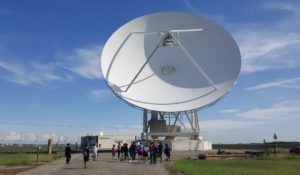 With a bus offered by the Municipality of Ozzano dell’Emilia, participants went on a trip to the Visitor Centre Marcello Ceccarelli in Medicina, just beside the large radiotelescopes of Medicina. Under the guidance of Simona Righini, researcher of INAF IRA, pupils were accompanied to the discovery of Radioastronomy, of the instruments with which the Universe is investigated on radio frequencies, and of the active research projects in our country.
With a bus offered by the Municipality of Ozzano dell’Emilia, participants went on a trip to the Visitor Centre Marcello Ceccarelli in Medicina, just beside the large radiotelescopes of Medicina. Under the guidance of Simona Righini, researcher of INAF IRA, pupils were accompanied to the discovery of Radioastronomy, of the instruments with which the Universe is investigated on radio frequencies, and of the active research projects in our country.
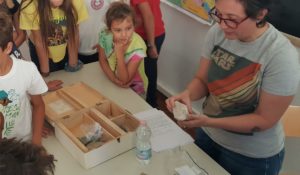 With Valentina Ferrante, researcher of CNR ISMAR in Bologna, participants travelled through the Geology of Star Wars, thus realizing how various morphological structures present on Earth, Mars and a few satellites of the Solar System are formed, and how certain settings of Star Wars actually are environments on the Earth. The researcher also brought a few samples of magmatic, sedimentary and metamorphic rocks, which participants could analyze. At the end of the 60 min. lesson, we suggested that participants should realize a multi-level video game with Scratch, based on their own labyrinths.
With Valentina Ferrante, researcher of CNR ISMAR in Bologna, participants travelled through the Geology of Star Wars, thus realizing how various morphological structures present on Earth, Mars and a few satellites of the Solar System are formed, and how certain settings of Star Wars actually are environments on the Earth. The researcher also brought a few samples of magmatic, sedimentary and metamorphic rocks, which participants could analyze. At the end of the 60 min. lesson, we suggested that participants should realize a multi-level video game with Scratch, based on their own labyrinths.
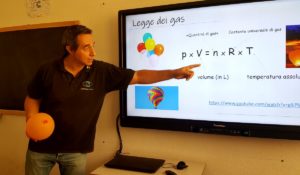 Gianluca Morgante, researcher of INAF OAS in Bologna, talked about cryogenics, starting from the laws of thermodynamics, and discussing of its impact on scientific research (Astrophysics, Biology, Medicine). While playing with liquid nitrogen (minus 190°), he brought pupils closer to the Physics of materials, by studying their behaviour at low temperatures, and observing changes of status not visible under normal conditions. The lesson/lab lased for the whole morning.
Gianluca Morgante, researcher of INAF OAS in Bologna, talked about cryogenics, starting from the laws of thermodynamics, and discussing of its impact on scientific research (Astrophysics, Biology, Medicine). While playing with liquid nitrogen (minus 190°), he brought pupils closer to the Physics of materials, by studying their behaviour at low temperatures, and observing changes of status not visible under normal conditions. The lesson/lab lased for the whole morning.
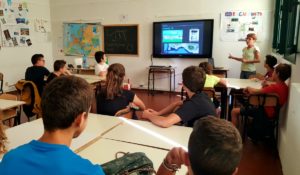 Participants completed their programmes and uploaded them in the shared folder. Later on, the researcher Laura Sandri of the Istituto di Geofisica e Vulcanologia di Bologna, accompanied them in an “explosive journey around the planet”, talking about the formation of volcanoes; which ones are the most dangerous in the planet (with particular reference to Italy), and making them understand, through a practical experience which participants made on their own, the importance of viscosity in determining the kind of volcanic eruption.
Participants completed their programmes and uploaded them in the shared folder. Later on, the researcher Laura Sandri of the Istituto di Geofisica e Vulcanologia di Bologna, accompanied them in an “explosive journey around the planet”, talking about the formation of volcanoes; which ones are the most dangerous in the planet (with particular reference to Italy), and making them understand, through a practical experience which participants made on their own, the importance of viscosity in determining the kind of volcanic eruption.
For further information, please write to Maura Sandri.

